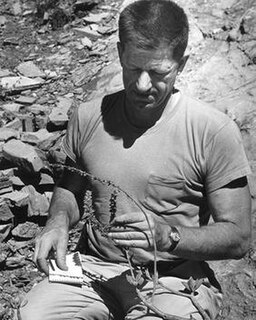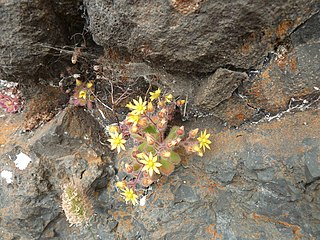
The Saxifragales (saxifrages) are an order of flowering plants (Angiosperms). They are an extremely diverse group of plants which include trees, shrubs, perennial herbs, succulent and aquatic plants. The degree of diversity in terms of vegetative and floral features makes it difficult to define common features that unify the order.

The Crassulaceae, also known as the stonecrop family or the orpine family, are a diverse family of dicotyledon flowering plants characterized by succulent leaves and a unique form of photosynthesis, known as Crassulacean acid metabolism (CAM). Flowers generally have five floral parts. Crassulaceae are usually herbaceous but there are some subshrubs, and relatively few treelike or aquatic plants. Crassulaceae are a medium size monophyletic family in the core eudicots, among the order Saxifragales, whose diversity has made infrafamilial classification very difficult. The family includes approximately 1,400 species and 34–35 genera, depending on the circumscription of the genus Sedum, and distributed over three subfamilies. Members of the Crassulaceae are found worldwide, but mostly in the Northern Hemisphere and southern Africa, typically in dry and/or cold areas where water may be scarce, although a few are aquatic.

Kalanchoe, or kal-un-KOH-ee, or kal-un-kee, also written Kalanchöe or Kalanchoë, is a genus of about 125 species of tropical, succulent flowering plants in the family Crassulaceae, mainly native to Madagascar and tropical Africa. Kalanchoe was one of the first plants to be sent into space, sent on a resupply to the Soviet Salyut 1 space station in 1971.

Sempervivum is a genus of about 40 species of flowering plants in the family Crassulaceae, commonly known as houseleeks. Other common names include liveforever and hen and chicks, a name shared with plants of other genera as well. They are succulent perennials forming mats composed of tufted leaves in rosettes. In favourable conditions they spread rapidly via offsets, and several species are valued in cultivation as groundcover for dry, sunny locations.

Aeonium, the tree houseleeks, is a genus of about 35 species of succulent, subtropical plants of the family Crassulaceae. Many species are popular in horticulture. The genus name comes from the ancient Greek "aionos" (ageless). While most of them are native to the Canary Islands, some are found in Madeira, Morocco, and in East Africa.

Aichryson is a genus of about 15 species of succulent, subtropical plants, mostly native to the Canary Islands, with a few in the Azores, Madeira and Morocco, and one in Portugal.

Monanthes is a genus of small, succulent, subtropical plants of the family Crassulaceae. The about ten species are mostly endemic to the Canary Islands and Savage Islands, with some found on Madeira. Its center of diversity is Tenerife, with seven species occurring on this island. On Fuerteventura and Lanzarote, only M. laxiflora occurs. Monanthes is a rare example where a species re-colonizes the continent from an island, after their ancestors have colonized the island from the continent.

Dudleya virens, the green liveforever or bright green dudleya, is an uncommon species of perennial, succulent plant in the family Crassulaceae, native to several coastal southern California and Baja California locations.
Antonina Georgievna Borissova (1903–1970) was a Russian botanist, specialising in the flora of the deserts and semi-desert of central Asia. Borissova authored 195 land plant species names, the ninth-highest number of such names authored by any female scientist.

Bryophyllum is a group of plant species of the family Crassulaceae native to Madagascar. It is a section or subgenus within the genus Kalanchoe, and was formerly placed at the level of genus. This section is notable for vegetatively growing small plantlets on the fringes of the leaves; these eventually drop off and root. These plantlets arise from mitosis of meristematic-type tissue in notches in the leaves.

Aeonium nobile is a succulent, subtropical flowering plant in the family Crassulaceae. It is native to the island of La Palma in the Canary Islands, where it grows on dry slopes and cliffs at altitudes up to 800m. The inflorescences are large and spreading with bright red flowers.

Kalanchoe farinacea is a species of plant in the family Crassulaceae. It is endemic to the Yemeni island of Socotra. Its natural habitat is subtropical or tropical dry shrubland at an altitude of 100-800m. While it is listed by International Union for Conservation of Nature(IUCN) as belonging to the order Rosales, Kalanchoes and other Crassulaceae are more usually placed in Saxifragales.

In botany, succulent plants, also known as succulents, are plants with parts that are thickened, fleshy, and engorged, usually to retain water in arid climates or soil conditions. It is a characteristic that is not used scientifically for the definition of most families and genera of plants because it often can be used as an accurate characteristic only at the single species level. The word succulent comes from the Latin word sucus, meaning 'juice', or 'sap'. Succulent plants may store water in various structures, such as leaves and stems. Some definitions also include roots, thus geophytes that survive unfavorable periods by dying back to underground storage organs may be regarded as succulents. In horticultural use, the term succulent is sometimes used in a way that excludes plants that botanists would regard as succulents, such as cacti. Succulents are often grown as ornamental plants because of their striking and unusual appearance, as well as their ability to thrive with relatively minimal care.

Aeonium urbicum is a succulent species of flowering plant in the family Crassulaceae. It is endemic to Tenerife, one of the Canary Islands, where it frows on the north of the island from Teno point to the Anaga peninsula. Until 1999, it was also considered a resident of La Gomera, another Canary Island, but that year the populations on that island were considered a new species and named Aeonium appendiculatum.

Reid Venable Moran was an American botanist and the curator of botany at the San Diego Natural History Museum from 1957 to 1982.

Aichryson villosum is a species of herbaceous flowering plants in the family Crassulaceae endemic to the Madeira Archipelago. The species was first described by Sabin Berthelot and Philip Barker-Webb in 1840, published in Natural History of the Canary Islands. Aichryson santamariensis was previously included in this species, but is now considered a different species endemic to Santa Maria Island, Azores.

Sempervivoideae is the largest of three subfamilies in the Saxifragales family Crassulaceae, with about 20–30 genera with succulent leaves. Unlike the two smaller subfamilies, it is distributed in temperate climates. The largest genus in this subfamily is Sedum, with about 470 species.

Aichryson divaricatum is a species of succulent plant of the family Crassulaceae endemic to Madeira.
Aeonium glandulosum is a critically endangered species of succulent plant of the family Crassulaceae endemic to Madeira.
















